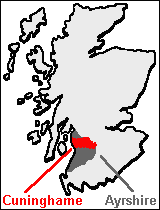 |
The family of Cunynghame, also spelt Cuninghame or Cunningham, were associated with the county of Ayrshire, in Scotland, in medieval times. They were especially associated with the area also called Cunninghame, to the north of modern Ardrossan and Kilmarnock. The family survives in several lines but these pages are concerned with the early branches of the family.
Many Doigs have a descent from the Cuninghames of Kilmaurs through descent from Dorothy Cuninghame, wife of James Dog of Dunrobin in the late sixteenth century. The sources disagree over the earliest generations of the Kilmaurs line, and these are discussed on a separate page. This line starts with those generations which can be reliably traced: |
 1. Sir Hugh de Cunynghame of Kilmaurs (ancestors)
1. Sir Hugh de Cunynghame of Kilmaurs (ancestors)
Hugh's parentage is not entirely certain.
2. Sir William de Cunynghame of Kilmaurs, Earl of Carrick; married (1) Lady Eleanor Bruce (died 22 June 1368), daughter of Alexander, Earl of Carrick and Margaret Douglas; married (2) before 18 Apr 1369, Margaret. William died between Dec 1396 and Jul 1399.
William was Hugh's successor and was probably his son. He was created Earl of Carrick in 1361 by King David II Bruce, probably by virtue of marrying Lady Eleanor Bruce, cousin to the King. She ought not to have received the title as it was restricted to the male-line heirs of Edward Bruce, but exception was made for her. This title reverted to the Crown on the death of Lady Eleanor, in William's own lifetime. Some sources doubt the existence of Eleanor but do not explain how William could otherwise become earl.
Burke notes: "The charter in his favour is on record, and singularly incomplete, as if there had been a doubt as to the propriety of the grant:- 'David, D.G. Rex Scottorum, sciatus nos dedisse concessisse et hac presenti-carta confirmasse dilicto consanguineo nostro Willielmo de Cuninghame militi totum comitatum de Carryk.' ". The charter is not dated but was probably written at Aberdeen on 12 September 1361.
3. Sir William de Cunynghame of Kilmaurs; married Margaret de Danyelston or Dennieston, daughter of Sir Robert. William died after 1404.
William resigned his estates in 1400 for a new infeftment from King Robert III. He was granted or regranted the lands and baronies of Kilmaurs, Lambrachton, Kilbryde, Skelmorlie, and Polquharne, Ayrshire; the lands and barony of Redhall, co. Edinburgh; the lands of Nevy, Forfarshire; the barony of Hassingden, Roxburghshire;and the lands of Ranfurley, in barony of Renfrew.
The baronies of Glencairn and Fynlayston also came into the Cuninghame family in this generation, as they were inherited by Margaret de Danyelston as elder co-heir of her father.
4. Sir Robert de Cunynghame of Kilmaurs; married in 1425 to Anne Montgomerie, daughter of Sir John of Ardrossan and Agnes (?MacDonald) of the Isles. Robert died between 1447 and 1451.
Robert had a charter of the lands of Kilmaurs from Robert, Duke of Albany, Governor of Scotland. He was one of the jury that tried and convicted Murdoch, Duke of Albany during the reign of King James I for Albany's failure to secure the young king's release from English imprisonment.
5. Alexander de Cunynghame, Lord of Kilmaurs, Earl of Glencairn; married Margaret Hepburn, daughter of Sir Adam of Hailes and Janet Borthwick. Alexander was killed on 11 June 1488 at the Battle of Sauchieburn, near Stirling, Scotland.
Alexander was created Lord Kilmaurs in about 1450. In 1460 he petitioned the Pope with regard to his right to present to the parish of Glencairn (in west Nithsdale, Dumfriesshire). He was created a Lord of Parliament as Lord Kilmaurs in 1463/64. He was a strong supporter of James III against the rebel nobles headed by Prince James, and was created Earl of Glencairn on 28 May 1488. He also got a grant of land for himself and his heirs. The king was defeated at the Battle of Sauchieburn shortly after and the earl was killed alongside the king. His earldom was revoked by the new King James IV's parliament, but was later recovered by his successors.
Go to other family branches:
View the sources used in the construction of these pages.
© 1999-2002
Created: 17 December 1999
Last modified: 15 March 2000

This page has been visited ![[counter]](http://viswww.oocities.org/it/counter.gif) times
since 17 December 1999.
times
since 17 December 1999.